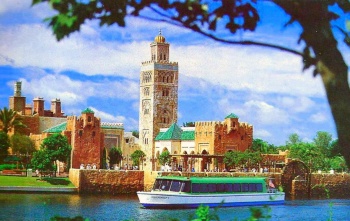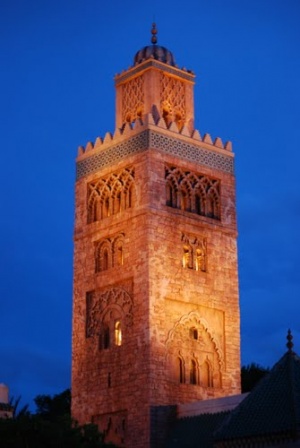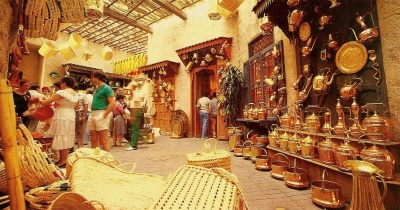Difference between pages "Japan" and "Morocco"
(→Attractions) |
(→Attractions) |
||
| Line 1: | Line 1: | ||
| − | |||
<html> | <html> | ||
<style> | <style> | ||
.smaller img { | .smaller img { | ||
| − | width: | + | width: 350px; |
| − | height: | + | height: 300x; |
} | } | ||
</style> | </style> | ||
| Line 10: | Line 9: | ||
</html> | </html> | ||
{{Template:Infobox Disney ride | | {{Template:Infobox Disney ride | | ||
| − | | image= | + | | image=Moroccopavilion2.jpg |
| − | | caption='''The | + | | caption='''The Morocco pavilion from across World Showcase Lagoon''' |
| − | | Country= | + | | Country=Morocco |
| land=World Showcase | | land=World Showcase | ||
| park= Epcot | | park= Epcot | ||
| Line 19: | Line 18: | ||
| custom_value_1 = 0 | | custom_value_1 = 0 | ||
| custom_label_2 = Number of Restaurants | | custom_label_2 = Number of Restaurants | ||
| − | | custom_value_2= | + | | custom_value_2= 4}} |
<html> | <html> | ||
</div> | </div> | ||
</html> | </html> | ||
| + | Morocco is a pavilion located within World Showcase in [[Epcot]]. It is located between the [[Japan]] and [[France]]. | ||
| + | ==History== | ||
| + | Morocco was one of the countries planned for World Showcase dating back to 1978 <ref> http://progresscityusa.com/2011/06/19/epcot-origins-a-model-future-1978/ </ref>. In fact, when Disney CEO Card Walker revealed the companies plans for EPCOT Center in the cast member Eyes and Ears magazine, he noted that Morocco was one of the first ten countries to sign a letter of intent to participate in World Showcase. Although the pavilion was not an opening day pavilion, Moroccan themed bathrooms were operational on EPCOT Center’s opening day <ref name= "potties"> http://progresscityusa.com/2010/02/16/the-mystical-potties-of-morocco/ </ref>. Construction on the rest of the pavilion then began in late 1982, with the official groundbreaking taking place in 1983 <ref name= "potties"/>. Finally, on September 7, 1984 the Morocco pavilion officially opened <ref> https://www.mouseplanet.com/guide/430/Walt-Disney-World/Epcot/World-Showcase--Morocco/ </ref>. Since the pavilion opened it has seen a relatively few number of changes. Besides the changing of many of the shops located in the marketplace, the only major changes in Morocco have been the addition of the Tangierine Café on September 30, 1999 <ref> http://www.intercot.com/discussion/archive/index.php?t-195363.html </ref> (which replaced the tourism bureau) and the addition of Spice Road Table in January 2014 <ref> http://www.wdwmagic.com/dining/spice-road-table/news/11jan2014-review---spice-road-table-at-epcot's-morocco-pavilion.htm </ref>. | ||
| − | == | + | ==Layout <ref> http://land.allears.net/blogs/jackspence/2011/10/morocco_pavilion_part_one.html </ref> <ref> http://land.allears.net/blogs/jackspence/2011/10/morocco_pavilion_part_two.html </ref>== |
| − | + | [[Image:Moroccopavilion.jpg|300px|thumb|The Koutoubia Minaret in the Morocco pavilion]] | |
| + | Unlike the other countries in World Showcase, the Morocco pavilion was directly sponsored by the country it represented. In fact, King Hassan II (the King of Morocco) sent craftsmen and artisans to help Disney design and create the pavilion. Since Islamic religion prohibits the artistic depiction of live objects, the decorations in the Morocco pavilion were all decorated with geometric patterns. Like many cities in Morocco, the pavilion is divided into ville nouvel (the “new city” which is located in the front of the pavilion) and medina (the “old city” which is located in the pavilion’s rear). The "Bab Boujouloud Gate", which was inspired by a similar structure found in Fez, separates the two areas. | ||
| − | + | Located in the ville nouvel is the pavilion’s gardens, which includes a working waterwheel (located on the lagoon) that brings water to the gardens. The new city part of the pavilion is also home to the Koutoubia Minaret. The largest structure in the pavilion, the minaret is a replica of the Koutoubia Mosque Minaret found in the city of Marrakesh. At one time, guests could visit the Center of Tourism in the Moroccan pavilion where they could obtain vacation planning literature and even book flights on Royal Air Maroc. This area has since been replaced by the counter service restaurant [[Tangierine Café]]. | |
| − | + | After passing through the Bab Boujouloud Gate, there is a noticeable change in the pavilion’s design. Instead of the broad streets and ordered building placement of the ville nouvel, the medina is more narrow and winding. The majority of the medina is taken up by the pavilion’s marketplace, where guests can purchase all sorts of authentic Moroccan merchandise. In the marketplace guests can also find the pavilion’s Kidcot station, where they can get their Epcot passports stamped. Although the marketplace is themed to look like it is outdoors, the entire area is covered by a well hidden roof. This was done to protect both guests and the merchandise from Florida’s elements. | |
| − | + | ||
| − | + | ||
| − | + | Another point of interest in the Moroccan pavilion is the Fez house. Here, guests can tour an authentic Moroccan home. Nearby another minaret, which is a replica of a minaret found in Chellah (a historic site near the city of Rabat), can be seen. Also located in the old town section of the Moroccan pavilion are an ancient water clock (which is a replica of a clock found in Fez) and a replica of the Nejjarine Fountain. | |
| − | + | ==Attractions== | |
| + | At this time, the Morocco pavilion does not feature any attractions. | ||
| − | + | ==Shopping== | |
| + | The Moroccan pavilion features a wide variety of shops, most of which are located in the pavilion's marketplace. | ||
| − | + | '''Tangier Traders'''- Here guests can purchase traditional clothing and shoes among other authentic merchandise. | |
| − | ''' | + | |
| − | ''' | + | '''Brass Bazaar'''- This shop sells artisan products including decorative plates and mirrors. The shop also features an outdoor bazaar where guests can purchase ceramic tiles and handmade baskets. |
| − | + | '''Medina Arts'''- This shop offers traditional ceramic Tajine and ceramic plates. | |
| − | ''' | + | |
| − | + | '''Casablanca Carpets'''- At this store guests can purchase hand knotted carpets and rugs. | |
| − | ''' | + | |
| − | ''' | + | '''Souk-Al-Magreb'''- This store offers a wide variety of Moroccan merchandise, including Fez hats, wind chimes and Henna Lamps. |
| + | [[Image:MoroccoShop.jpg|400px|thumb|The inside of one of the many shops found in the Morocco pavilion]] | ||
| + | ===Former Shopping=== | ||
| − | + | Throughout its history the Morocco pavilion has housed many different shops. Stores that were once located within the pavilion included: | |
| − | ''' | + | '''Berber Oasis''' |
| − | ''' | + | '''Fashions From Fez''' |
| − | + | '''Jewels of the Sahara''' | |
| − | ''' | + | |
| − | + | ||
| − | + | ||
| − | ''' | + | |
| − | + | '''Kasbash Woodcrafts''' | |
| − | + | ||
| − | + | '''Mekens Potters''' | |
| − | + | ==Restaurants== | |
| + | '''[[Tangierine Café]]-''' Located in the "new city" portion of the Moroccan pavilion, this counter service restaurant serves traditional Moroccan cuisine. Guests can get sandwiches and wraps here, along with other Mediterranean specialties. | ||
| − | + | '''[[Restaurant Marrakesh]]-''' This table service restaurant is located in the "old city" portion of the Moroccan pavilion. Here guests can get a traditional Moroccan meal, including a number of lamb and chicken dishes. | |
| − | + | '''[[Morocco Coffee & Pastries]]-''' This bakery allows guests to purchase authentic Moroccan sweets. | |
| − | + | '''[[Spice Road Table]]'''- Morocco’s newest dining establishment is a tapas restaurant located on the World Showcase promenade. Spice Road Table also offers various Mediterranean wines. | |
| − | + | ||
| − | + | ==Entertainment== | |
| + | '''Musique Aramenco'''- This three piece band plays a fusion of modern and traditional Moroccan music. | ||
| + | ===Former Entertainment=== | ||
| − | + | '''Mo'Rockin'''- This five piece band combined rock and roll music with traditional Arabic rhythms. Mo'Rockin performed in the pavilion from 1999 until 2014. | |
| − | http:// | + | ''' B'net Al Houwariyate'''- This group played traditional music including "rural Berber chants and Chaabi festival rhythms". B'net Al Houwariyate performed from October 2014 until November 2015. <ref> http://www.wdwmagic.com/attractions/bnet-al-houwariyate/news/21oct2015-moroccos-bnet-al-houwariyate-leaves-epcot.htm </ref> |
| + | |||
| + | '''Ribab Fusion'''- This funky band showcased Morocco's Amazigh (Berber) culture. | ||
| + | |||
| + | ==Fun Facts and Trivia== | ||
| + | * Since guests can see the Tower of Terror behind the Morocco pavilion, the top of the Tower was designed to blend in with the architecture of Morocco <ref> http://towersecrets.com/see-the-tower-of-terror-from-inside-epcot/ </ref>. | ||
| + | |||
| + | * Morocco is the only country in World Showcase which the government of the host country actually helped design and construct <ref> The Epcot Explorer's Encyclopedia: A Guide to Walt Disney World's Greatest Theme Park </ref>. | ||
| + | |||
| + | * Morocco is the only country besides [[Germany]] to have a Friendship Boat dock located within its pavilion <ref> https://touringplans.com/epcot/attractions/friendship-boats </ref>. | ||
| + | |||
| + | * For a while, guests could take "The Treasures of Morocco" tour around the pavilion. The tour was free and lasted 45 minutes <ref> http://allears.net/ae/issue095.htm </ref>. | ||
| + | |||
| + | * If guests pay close attention, they may notice that Imagineers produced the smell of incense and the sound of rural animals in the marketplace. This was done to make the area seem as authentic as possible <ref> http://land.allears.net/blogs/jackspence/2011/10/morocco_pavilion_part_two.html </ref>. | ||
| + | |||
| + | ==References== | ||
Latest revision as of 10:34, 15 February 2020
| Morocco | |

| |
| The Morocco pavilion from across World Showcase Lagoon | |
| Epcot | |
| Land | World Showcase |
|---|---|
| Opening date | October 1, 1982 |
| Number of Attractions | 0 |
| Number of Restaurants | 4 |
|
| |
Contents
History
Morocco was one of the countries planned for World Showcase dating back to 1978 [1]. In fact, when Disney CEO Card Walker revealed the companies plans for EPCOT Center in the cast member Eyes and Ears magazine, he noted that Morocco was one of the first ten countries to sign a letter of intent to participate in World Showcase. Although the pavilion was not an opening day pavilion, Moroccan themed bathrooms were operational on EPCOT Center’s opening day [2]. Construction on the rest of the pavilion then began in late 1982, with the official groundbreaking taking place in 1983 [2]. Finally, on September 7, 1984 the Morocco pavilion officially opened [3]. Since the pavilion opened it has seen a relatively few number of changes. Besides the changing of many of the shops located in the marketplace, the only major changes in Morocco have been the addition of the Tangierine Café on September 30, 1999 [4] (which replaced the tourism bureau) and the addition of Spice Road Table in January 2014 [5].
Layout [6] [7]
Unlike the other countries in World Showcase, the Morocco pavilion was directly sponsored by the country it represented. In fact, King Hassan II (the King of Morocco) sent craftsmen and artisans to help Disney design and create the pavilion. Since Islamic religion prohibits the artistic depiction of live objects, the decorations in the Morocco pavilion were all decorated with geometric patterns. Like many cities in Morocco, the pavilion is divided into ville nouvel (the “new city” which is located in the front of the pavilion) and medina (the “old city” which is located in the pavilion’s rear). The "Bab Boujouloud Gate", which was inspired by a similar structure found in Fez, separates the two areas.
Located in the ville nouvel is the pavilion’s gardens, which includes a working waterwheel (located on the lagoon) that brings water to the gardens. The new city part of the pavilion is also home to the Koutoubia Minaret. The largest structure in the pavilion, the minaret is a replica of the Koutoubia Mosque Minaret found in the city of Marrakesh. At one time, guests could visit the Center of Tourism in the Moroccan pavilion where they could obtain vacation planning literature and even book flights on Royal Air Maroc. This area has since been replaced by the counter service restaurant Tangierine Café.
After passing through the Bab Boujouloud Gate, there is a noticeable change in the pavilion’s design. Instead of the broad streets and ordered building placement of the ville nouvel, the medina is more narrow and winding. The majority of the medina is taken up by the pavilion’s marketplace, where guests can purchase all sorts of authentic Moroccan merchandise. In the marketplace guests can also find the pavilion’s Kidcot station, where they can get their Epcot passports stamped. Although the marketplace is themed to look like it is outdoors, the entire area is covered by a well hidden roof. This was done to protect both guests and the merchandise from Florida’s elements.
Another point of interest in the Moroccan pavilion is the Fez house. Here, guests can tour an authentic Moroccan home. Nearby another minaret, which is a replica of a minaret found in Chellah (a historic site near the city of Rabat), can be seen. Also located in the old town section of the Moroccan pavilion are an ancient water clock (which is a replica of a clock found in Fez) and a replica of the Nejjarine Fountain.
Attractions
At this time, the Morocco pavilion does not feature any attractions.
Shopping
The Moroccan pavilion features a wide variety of shops, most of which are located in the pavilion's marketplace.
Tangier Traders- Here guests can purchase traditional clothing and shoes among other authentic merchandise.
Brass Bazaar- This shop sells artisan products including decorative plates and mirrors. The shop also features an outdoor bazaar where guests can purchase ceramic tiles and handmade baskets.
Medina Arts- This shop offers traditional ceramic Tajine and ceramic plates.
Casablanca Carpets- At this store guests can purchase hand knotted carpets and rugs.
Souk-Al-Magreb- This store offers a wide variety of Moroccan merchandise, including Fez hats, wind chimes and Henna Lamps.
Former Shopping
Throughout its history the Morocco pavilion has housed many different shops. Stores that were once located within the pavilion included:
Berber Oasis
Fashions From Fez
Jewels of the Sahara
Kasbash Woodcrafts
Mekens Potters
Restaurants
Tangierine Café- Located in the "new city" portion of the Moroccan pavilion, this counter service restaurant serves traditional Moroccan cuisine. Guests can get sandwiches and wraps here, along with other Mediterranean specialties.
Restaurant Marrakesh- This table service restaurant is located in the "old city" portion of the Moroccan pavilion. Here guests can get a traditional Moroccan meal, including a number of lamb and chicken dishes.
Morocco Coffee & Pastries- This bakery allows guests to purchase authentic Moroccan sweets.
Spice Road Table- Morocco’s newest dining establishment is a tapas restaurant located on the World Showcase promenade. Spice Road Table also offers various Mediterranean wines.
Entertainment
Musique Aramenco- This three piece band plays a fusion of modern and traditional Moroccan music.
Former Entertainment
Mo'Rockin- This five piece band combined rock and roll music with traditional Arabic rhythms. Mo'Rockin performed in the pavilion from 1999 until 2014.
B'net Al Houwariyate- This group played traditional music including "rural Berber chants and Chaabi festival rhythms". B'net Al Houwariyate performed from October 2014 until November 2015. [8]
Ribab Fusion- This funky band showcased Morocco's Amazigh (Berber) culture.
Fun Facts and Trivia
- Since guests can see the Tower of Terror behind the Morocco pavilion, the top of the Tower was designed to blend in with the architecture of Morocco [9].
- Morocco is the only country in World Showcase which the government of the host country actually helped design and construct [10].
- Morocco is the only country besides Germany to have a Friendship Boat dock located within its pavilion [11].
- For a while, guests could take "The Treasures of Morocco" tour around the pavilion. The tour was free and lasted 45 minutes [12].
- If guests pay close attention, they may notice that Imagineers produced the smell of incense and the sound of rural animals in the marketplace. This was done to make the area seem as authentic as possible [13].
References
- ↑ http://progresscityusa.com/2011/06/19/epcot-origins-a-model-future-1978/
- ↑ 2.0 2.1 http://progresscityusa.com/2010/02/16/the-mystical-potties-of-morocco/
- ↑ https://www.mouseplanet.com/guide/430/Walt-Disney-World/Epcot/World-Showcase--Morocco/
- ↑ http://www.intercot.com/discussion/archive/index.php?t-195363.html
- ↑ http://www.wdwmagic.com/dining/spice-road-table/news/11jan2014-review---spice-road-table-at-epcot's-morocco-pavilion.htm
- ↑ http://land.allears.net/blogs/jackspence/2011/10/morocco_pavilion_part_one.html
- ↑ http://land.allears.net/blogs/jackspence/2011/10/morocco_pavilion_part_two.html
- ↑ http://www.wdwmagic.com/attractions/bnet-al-houwariyate/news/21oct2015-moroccos-bnet-al-houwariyate-leaves-epcot.htm
- ↑ http://towersecrets.com/see-the-tower-of-terror-from-inside-epcot/
- ↑ The Epcot Explorer's Encyclopedia: A Guide to Walt Disney World's Greatest Theme Park
- ↑ https://touringplans.com/epcot/attractions/friendship-boats
- ↑ http://allears.net/ae/issue095.htm
- ↑ http://land.allears.net/blogs/jackspence/2011/10/morocco_pavilion_part_two.html

